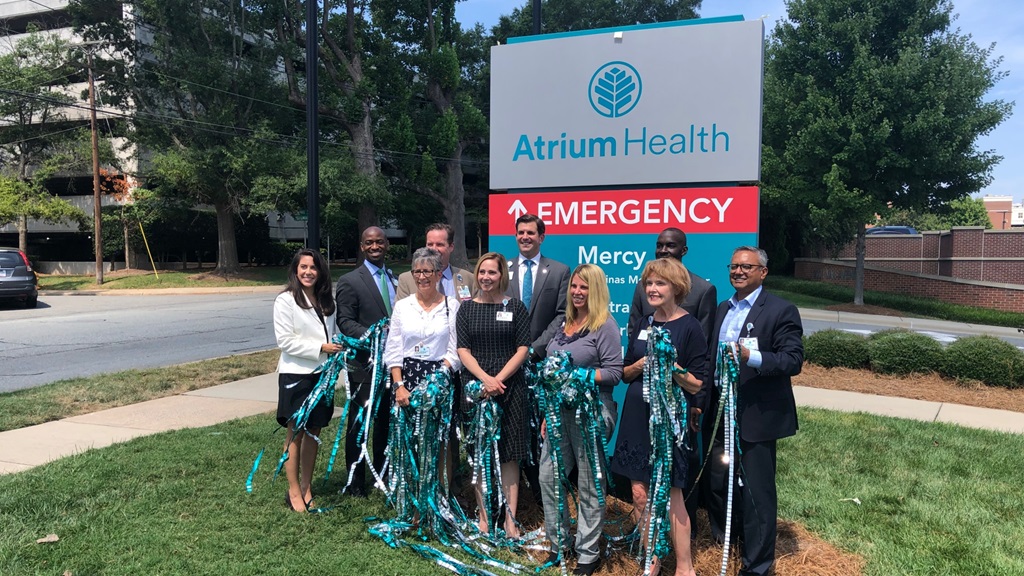The name change from “Carolinas Medical Center-Mercy” to “Atrium Health Mercy” is but the latest in a series of historic milestones dating back more than a century.
The original facility, Mercy General Hospital, opened in 1906 in the parish hall of St. Peter’s Catholic Church in uptown Charlotte. In 1916 the Sisters of Mercy, who owned and operated the hospital, built a new 75-bed facility, complete with a nursing school, on the site of the current campus in Elizabeth.
This marked the start of a long period of sustained growth that ultimately resulted in creation of the 185-bed hospital we know today.
Lynda Opdyke, MSN, has been associated with Mercy for more than 40 years. She started teaching at the Mercy School of Nursing in 1976, retired as a school administrator in 2011, and has remained active since as a volunteer. In fact, she helps maintain the hospital’s unique “history room,” which displays a century’s worth of hospital artifacts accumulated during the period of Sisters of Mercy ownership (1906-1995).
Opdyke says she stayed at Mercy for so long because of the hospital’s family atmosphere and strong commitment to quality patient care. This included a “love for people of all races,” which led to Mercy’s opening its doors to patients of color in 1954, long before de-segregation occurred at other Charlotte medical facilities.
She remembers her colleagues being apprehensive about the acquisition by Carolinas Medical Center, fearing that the Mercy’s special ethos and values might get swallowed up by bureaucracy.
“Fortunately,” she says, “those fears were ill-founded. As things played out, the changes were positive. We got a lot of new resources to enhance patient care, and we did not lose the sense of identity that was so important to us.”
Among her fond memories is the relationship she developed with Sister Mary Jerome Spradley, RSM, who served as president of Mercy Health Services. “I’m actually old enough to remember that Sister Jerome was once a Baptist,” Opdyke remembers with a smile. “She was not affiliated with the Sisters of Mercy when she first came to Mercy School of Nursing as a student. It was only later that she converted to Catholicism, earned a master’s degree, and went into healthcare administration.”
Sister Jerome was chief executive at the time Mercy Hospital and its Pineville satellite, Mercy South, were acquired by Carolinas Medical Center. She felt this acquisition was the best way to assure a strong future for her hospitals, but retained a strong interest in historic preservation, lest Mercy’s heritage of community service be lost.
Fortunately, she found a soulmate in Bill Merritt, currently an AVP at Atrium Health, who was project manager for the most recent re-construction project, completed in 2009. That renovation included a new parking deck (located on the site of the old Mercy School of Nursing and Convent), a new medical office building, and major renovations at the hospital to accommodate orthopedic procedures, training for family medicine residents and other key services.
Merritt is thought to be the only Atrium Health employee ever to win the Pinnacle Award twice. His first recognition came in 2006 for general excellence in project management. He was recognized again in 2008 for his extraordinary efforts to preserve and re-locate human remains found on the Mercy campus during ground-clearing.
When equipment operators uncovered a pile of tombstones dating back to the Revolutionary War era, Merritt ordered heavy equipment operators to clear the surrounding turf with special care. His suspicion that gravesites might be found close by proved correct. Workers eventually found burial sites for 13 individuals, all members of the “Sprot” family, many of whose descendants (now known as “Spratts”) still live in the area.
The discovery represented a critical turning point for the renovation for two reasons. One is that state archeological mandates related to historic gravesites can lead to construction delays of up to two years. Also, from a humanitarian standpoint, the matter had to be handled with keen attention to family and community sensitivities. Merritt is quick to praise the advisory group of family members and community leaders who came together to ensure proper handling of related details.
“As a footnote,” he says, “a great team effort enabled all the necessary archeological work to be completed in less than two months.”
The discovery turned out to be such an unusual story that media coverage went national. As a result, Atrium Health representatives were invited to speak at civic gatherings throughout the country, including a national convention of the Daughters of the American Revolution. In awarding Merritt’s second Pinnacle Award, then-CEO Michael Tarwater cited him for going above and beyond to ensure that everything was handled “the right way.”
Merritt, it turned out, was an experienced carpenter who used his personal skills to re-create coffins that were exact replicas of the type used during the 1770s. They were utilized when remains were re-interred, adjacent to other Spratt family gravesites at Steele Creek Presbyterian Church.
Another coincidence that came to light during this period was that Merritt himself had been born at Mercy Hospital in 1957. He jokes now that he doesn’t know many people “who get the chance to tear down the hospital they were born in.”
Merritt was happy to collaborate with Sister Jerome in preserving as much Mercy history as possible. Stained glass windows from the original chapel were re-installed with back lighting in the hospital’s current chapel. The original pews and altar were taken to Belmont Abbey College. The original copper cross that topped the main hospital entrance was restored and placed in the history room, where it still can be seen today.
Merritt says even though he was not on staff at Carolinas Medical Center-Mercy, he always noticed that the hospital had a “family feel,” an extraordinary number of long-time employees, and a great reputation throughout the community.
Chan Roush, Vice President, Facility Executive since 2017, says these are the types of characteristics that contributed to the hospital achieving its first “Planetree” designation in 2011.
Planetree is a national recognition program spotlighting hospitals that have organizational cultures focused on high quality, person-centered care. As further validation of that culture, Mercy achieved Planetree recognition again in 2014 and 2018.
“It’s a privilege for me to serve in a leadership role in a hospital that has so many positive attributes,” Roush says, “including a team that is highly regarded for clinical and technical skills, as well as for caring and empathy. The compliments I hear most often – whether from direct patient feedback or comments out in the community – relate to the caring demonstrated by our team. And those compliments are directed to every single member of the team, not just physicians and nurses. The Sisters of Mercy set a high bar for us, and we are proud to continue building on their remarkable legacy as Atrium Health Mercy."



